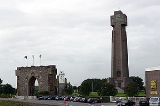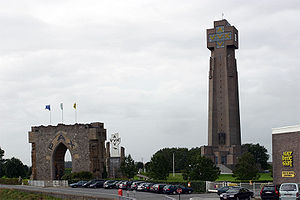
IJzertoren
Encyclopedia

Belgium
Belgium , officially the Kingdom of Belgium, is a federal state in Western Europe. It is a founding member of the European Union and hosts the EU's headquarters, and those of several other major international organisations such as NATO.Belgium is also a member of, or affiliated to, many...
Yser
Yser
The Yser is a river that finds its origin in the north of France, enters Belgium and flows into the North Sea at the town of Nieuwpoort.-In France:The source of the Yser is in Buysscheure, in the Nord département of northern France...
river in Diksmuide
Diksmuide
Diksmuide is a Belgian city and municipality in the Flemish province of West Flanders. The municipality comprises the city of Diksmuide proper and the former communes of Beerst, Esen, Kaaskerke, Keiem, Lampernisse, Leke, Nieuwkapelle, Oostkerke, Oudekapelle, Pervijze, Sint-Jacobs-Kapelle,...
. There have been two IJzertorens, the first built after the First World War
World War I
World War I , which was predominantly called the World War or the Great War from its occurrence until 1939, and the First World War or World War I thereafter, was a major war centred in Europe that began on 28 July 1914 and lasted until 11 November 1918...
by an organisation of former Flemish
Flanders
Flanders is the community of the Flemings but also one of the institutions in Belgium, and a geographical region located in parts of present-day Belgium, France and the Netherlands. "Flanders" can also refer to the northern part of Belgium that contains Brussels, Bruges, Ghent and Antwerp...
soldiers. On the night of 15 and 16 March 1946 it was illegally demolished with dynamite
Dynamite
Dynamite is an explosive material based on nitroglycerin, initially using diatomaceous earth , or another absorbent substance such as powdered shells, clay, sawdust, or wood pulp. Dynamites using organic materials such as sawdust are less stable and such use has been generally discontinued...
; the perpetrators were never caught, though there are strong indications of involvement of the Belgian military and anti-Flemish, French-speaking radicalists. Several years later, a new and higher tower was built on the same place. With the remains of the old tower, the Paxpoort or Pax-gate (Gate of Peace) was built.
The IJzertoren site is also the burial place of some Flemish soldiers killed on the battlefield, who have become examples and heroes for Flanders.
It is also the place where the myth of the "Van Raemdonck-brothers" is venerated. Legend says that both brothers were sergeants in the same regiment. After a successful offensive across the Yser River, Edward noticed that his brother wasn't with the regiment anymore. He turned back into enemy territory and was found in his brother's arms 19 days later.
Later, the Germans offered a half-hour fighting pause in order for both sides to be able to give the bodies of their lost ones a prober burial. A French-speaking general (Bernheim) of the Belgian Army replied: ""Je n'en vois pas la nécessité. D'ailleurs il s'est avéré que le plus jeune des deux était un flamingant" ("I don't see why. By the way, it's known that the youngest one was a flamingant (a person who believes in the emancipation of Flanders).
To which general Mahieu answered:
""En effet" ("Indeed")."
So far for the legend.
In reality, this legend has taken shape in the mind of Lodewijk Van Gelder, a former student of the well known flamingant Cyril Verschave and has been published by Clemens De Landtsheer (secretary to the Ijzerbedevaart from 1926 to 1984). The soldier who buried the brothers, Charles Withof, has an essentially different story. In fact, Frans Van Raemdonck was found dead, in the arms of Amé Fiévez, a Walloon corporal. Edward Van Raemdonck was found a couple of meters further. When Withof reported the erred story to De Landtsheer, the later replied to the former
Alhoewel ik volledig met u't akkoord ben op gebied van waarheidszin, toch denk ik dat we best zouden doen die zaak niet publiek rond te venten, en ze onder ons te houden, en in het publiek het gedacht te laten dat men ze IN ELKAARS ARMEN heeft gevonden, en ziehier om welke redens: hadden wij die inlichtingen gekend in 't begin, dan had alles zo geweest. Maar nu is hunne ideale heldendood overal gekend en al legendarisch geworden, waarom die schoonheid breken, en er de waarheid als een koud bad over uitstorten... dit zou zeer veel nadeel doen aan de zaak zelve. (..)Ik schrijf u deze brief heel vertrouwelijk en hoop nochtans dat gij uwe soldaten zult aanmanen de zaak dus zoo te laten voortleven... voor het welzijn van de zaak zelf en voor de arme ouders.
(translated: 'While I wholeheartedly agree with you with respect to the truthfulness of the matter, I none the less believe that we would do well not to make the matter publicly known, and to keep it to ourselves, and to leave the public to its conviction that they were found IN EACH OTHERS' ARMS, and this for the following reasons: had we known this information from the start, then everything would have been thusly. But now their ideal heroes' death is universally known and has already passed into legend, why then dispel this beauty, and pour out truth over it like a cold shower... this would greatly harm the cause itself. (...) I address this letter to you in the fullest of confidence, and hope yet that you will encourage your soldiers to allow the matter to live on thusly... for the benefit of the cause itself, and for the aggrieved parents.'
The IJzertoren symbolizes the demand for Nooit meer Oorlog (Never again War), written on the tower in the four languages of the fighting forces in the area during the First World War (Dutch, French, English and German). The rebuilt tower (84 m) is the highest peace monument in Europe.
The tower also sports the abbreviations AVV-VVK: Alles Voor Vlaanderen-Vlaanderen voor Kristus (All for Flanders-Flanders for Christ). It is a symbol of Flemish nationalism, especially regarding the rights to use the Dutch language
Dutch language
Dutch is a West Germanic language and the native language of the majority of the population of the Netherlands, Belgium, and Suriname, the three member states of the Dutch Language Union. Most speakers live in the European Union, where it is a first language for about 23 million and a second...
and the rights to political autonomy. The IJzertoren has been recognised by the Flemish parliament as the official memorial of Flemish emancipation, especially against the oppression by the French-speaking minority of Flemish art, culture, etc.
Every year at the end of August the political meeting IJzerbedevaart
IJzerbedevaart
The IJzerbedevaart is a yearly gathering of Flemings, at the IJzertoren in Diksmuide. This pilgrimage remembers the Flemish soldiers who died during the First World War and was first organised in 1920. It is at the same time a political meeting striving for Flemish political autonomy...
is organised next to the IJzertoren.
The IJzertoren houses a museum on Oorlog, vrede en Vlaamse ontvoogding (War, Peace, and Flemish Emancipation), that belongs to the United Nations
United Nations
The United Nations is an international organization whose stated aims are facilitating cooperation in international law, international security, economic development, social progress, human rights, and achievement of world peace...
network of peace museum
Peace museum
A peace museum is a museum that documents historical peace initiatives. Many peace museums also provide advocacy programs for nonviolent conflict resolution...
s. The museum houses the large painting The Golden Canvass of Flanders (“Het Gulden Doek van Vlaanderen”) by Dutch-born Belgian painter Henry Luyten
Henry Luyten
Henry Luyten was a Dutch-born Belgian painter.-Biography:Hendrik Luyten was born in Roermond, the Netherlands as the son of Francis Hubert Luyten and Johanna Hendrica de Bee . He studied at the Royal Academy of Fine Arts in Antwerp, Belgium from 1878...
. The painting depicts a fictional meeting of the one hundred people who in Henry Luyten's opinion played the most important role in the Flemish movement
Flemish movement
The Flemish Movement is a popular term used to describe the political movement for emancipation and greater autonomy of the Belgian region of Flanders, for protection of the Dutch language, and for the over-all protection of Flemish culture and history....
and Flemish history.

